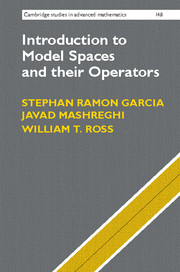Book contents
- Frontmatter
- Dedication
- Contents
- Preface
- Notation
- 1 Preliminaries
- 2 Inner functions
- 3 Hardy spaces
- 4 Operators on the Hardy space
- 5 Model spaces
- 6 Operators between model spaces
- 7 Boundary behavior
- 8 Conjugation
- 9 The compressed shift
- 10 The commutant lifting theorem
- 11 Clark measures
- 12 Riesz bases
- 13 Truncated Toeplitz operators
- References
- Index
Preface
Published online by Cambridge University Press: 05 May 2016
- Frontmatter
- Dedication
- Contents
- Preface
- Notation
- 1 Preliminaries
- 2 Inner functions
- 3 Hardy spaces
- 4 Operators on the Hardy space
- 5 Model spaces
- 6 Operators between model spaces
- 7 Boundary behavior
- 8 Conjugation
- 9 The compressed shift
- 10 The commutant lifting theorem
- 11 Clark measures
- 12 Riesz bases
- 13 Truncated Toeplitz operators
- References
- Index
Summary
This is an introductory text on model spaces that is aimed towards both graduate students and active researchers who wish to enter this evolving subject at a comfortable and digestible pace.
Model spaces have been studied, in one form or another, for the past 40 years, making connections to many areas of complex analysis (boundary behavior of analytic functions, analytic continuation, zero sets), operator theory (spectral properties, cyclic vectors, invariant subspaces, model operators for contractions, commutant lifting theorems, Hankel operators), engineering (the Darlington synthesis problem, control theory), and, more recently, to mathematical physics (completeness problems for Schrödinger and Sturm– Liouville operators). The purpose of this book is to present some of the basics of the subject in order to whet the appetite and to provide the newcomer with a solid foundation.
Many of the topics in this book were inspired by several series of lectures given by us at workshops in Montréal, Helsinki, Lens, Rennes, and Kashan where, during the course of these lectures, we became convinced of the need for students and researchers from adjacent fields to have a friendly introduction to model spaces and their operators.
This book is largely self-contained, although the reader is expected to be familiar with the basics of complex analysis, measure theory, and functional analysis. We briefly review these topics to establish our notation and, if necessary, to re-heat some possibly forgotten foundational topics. We develop and prove almost everything else, including a thorough treatment of the fundamentals of Hardy space theory, which is essential to the study of model spaces.
Since the list of topics we plan to cover is readily available in the table of contents, we would like to spend a few moments making the case for model spaces. Why should you keep on reading? Historically, model spaces began with the desire to characterize the cyclic vectors and invariant subspaces of the backward shift operator S* on the Hardy space H2. Beurling's 1949 theorem completely characterized the non-trivial invariant subspaces of the unilateral shift Sf = zf on H2 as uH2, where u is an inner function on the open unit disk D. By taking orthogonal complements, we see that the proper invariant subspaces of S* are the so-called model spaces Ku = (uH2)⊥.
- Type
- Chapter
- Information
- Introduction to Model Spaces and their Operators , pp. xi - xiiiPublisher: Cambridge University PressPrint publication year: 2016

